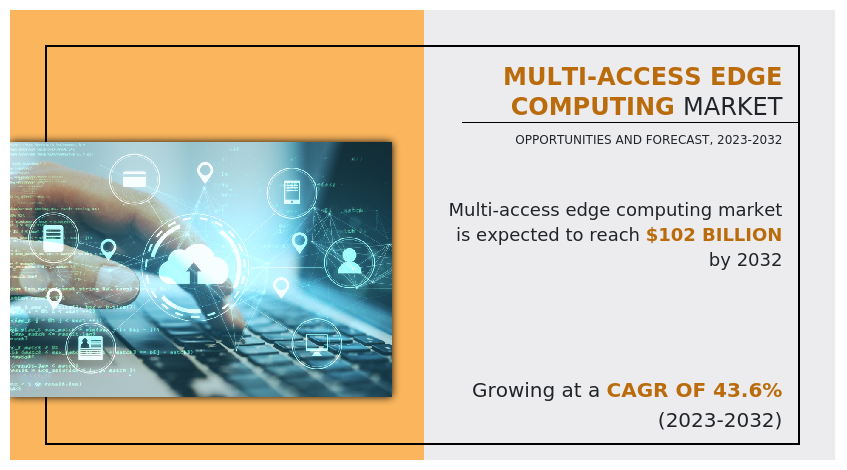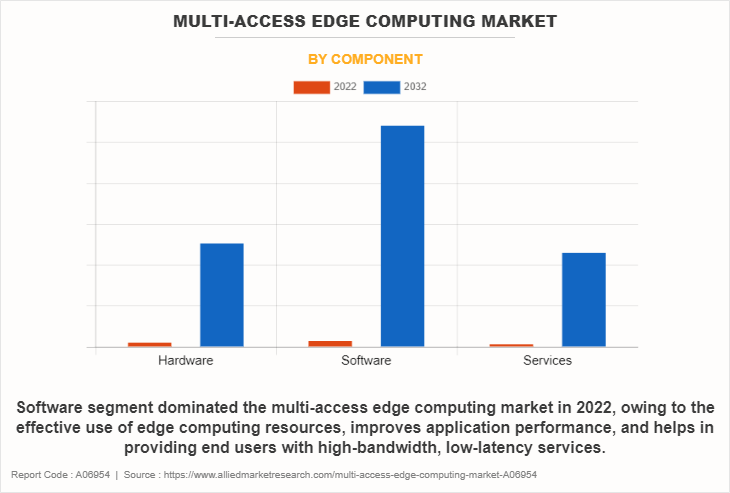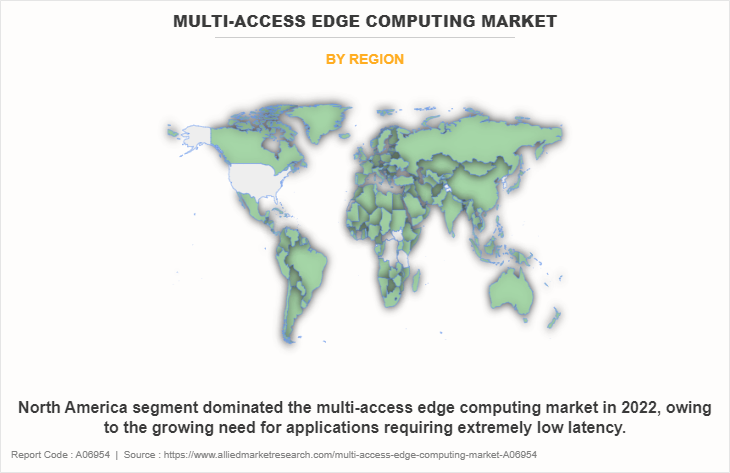Multi-access Edge Computing Market Insights:
The global multi-access edge computing market was valued at USD 2.8 billion in 2022 and is projected to reach USD 102 billion by 2032, growing at a CAGR of 43.6% from 2023 to 2032.
Surge in 5G network rollout and rise in adoption of IoT primarily drive the growth of the multi-access edge computing market. However, infrastructure costs and deployment challenges and concerns about security and privacy hamper market growth. Moreover, industry 4.0 and smart manufacturing is expected to provide lucrative opportunities for market growth during the forecast period.

MEC is a key component of edge computing, which has become significantly popular. As businesses are willing to utilize unparalleled potential of edge computing for low-latency, real-time data processing, the multi-access edge computing (MEC) market has expanded and changed quickly. The demand for MEC to process data closer to its source to reduce latency and improve reaction times is driven by the growth of Industry 4.0, 5G, and IoT networks. The market has witnessed an increase in edge deployments from a number of different businesses. One major factor driving the deployment of MEC is the development of 5G networks.
The high bandwidth and low latency characteristics of 5G have increased the efficiency of MEC. To support applications such as autonomous vehicles, augmented reality, and virtual reality, telecom providers invest in MEC. Moreover, as billions of IoT devices require real-time data processing, the Internet of Things (IoT) has propelled MEC's expansion. Fast decision-making at the edge is made possible by MEC, which boosts the effectiveness of IoT applications in industries including logistics, smart cities, and healthcare. However, privacy and security have become crucially important as MEC deployments increase. Businesses spend money on strong security solutions to safeguard sensitive data and edge equipment. Data sovereignty and privacy compliance are important factors, especially in the financial and healthcare sectors.
The multi-access edge computing market is segmented on the basis of component, end user, and region. On the basis of component, it is categorized into hardware, software, and services. On the basis of end user, it is fragmented into IT and telecom, manufacturing, retail, healthcare, automotive, smart cities, smart homes and smart buildings, and others.
The report focuses on growth prospects, restraints, and analysis of the multi-access edge computing trend. The study provides Porter's five forces analysis to understand the impact of numerous factors, such as the bargaining power of suppliers, the competitive intensity of competitors, the threat of new entrants, the threat of substitutes, and the bargaining power of buyers on the multi-access edge computing market share.

On the basis of component, software segment dominated the multi-access edge computing market in 2022 and is expected to maintain its dominance in the upcoming years owing to the effective use of edge computing resources, improves application performance, and helps in providing end users with high-bandwidth, low-latency services propels the market growth significantly. However, the service segment is expected to witness the highest growth, owing to improve operational efficiency, develop all new applications, and provide end consumers with quicker, more customized services in a variety of industries, such as manufacturing, transportation, telecommunications, and healthcare.

On the basis of region, the multi-access edge computing market size was dominated by North America in 2022 and is expected to retain its position during the forecast period, owing to the growing need for applications requiring extremely low latency and real-time data processing is crucial for sectors like autonomous vehicles, smart cities, and augmented reality (AR)/virtual reality (VR) aiding the growth of the market. However, Asia Pacific is expected to witness significant growth during the multi-access edge computing market forecast period, owing to the growing use of 5G technology as well as the rapid growth of IoT devices and applications which is expected to fuel the market growth in this region.
Top Impacting Factors:
5G Network Rollout
One major factor propelling the development and adoption of Multi-Access Edge Computing (MEC) is the deployment of 5G networks. With astonishingly low latency and high data transfer speeds, this game-changing synergy between 5G and MEC has transformed how industries function, data is processed, and applications are delivered. MEC deploys these 5G features to facilitate responsiveness and real-time interactions. Reduced data transfer delays to milliseconds has revolutionary implications for applications such as augmented reality, virtual reality, and driverless cars.
Moreover, industries implement time-sensitive applications, and users enjoy smooth and immersive content. By enabling edge computing capabilities, MEC enhances 5G by bringing data processing closer to end users or IoT devices. Data processing occurs at the edge of the network with 5G and MEC. Data is processed at the network's edge with 5G and MEC, which shortens the time it takes for data to travel to and from a centralized data center. For real-time decision-making in applications such as autonomous systems, telemedicine, and smart manufacturing, MEC is important.
Rise in Adoption of IoT
The market for Multi-Access Edge computing (MEC) has expanded as a result of the widespread adoption of IoT. The proliferation of IoT devices across diverse industries and applications has resulted in a great demand for real-time, low-latency data processing. By putting processing capacity closer to the IoT devices at the network's edge, MEC meets this need. The IoT is defined by an enormous number of networked sensors and devices. These gadgets produce enormous amounts of data that need to be processed right away. To analyze this data at the network edge, minimize latency, and enable real-time analytics, MEC offers the necessary infrastructure. Real-time decision-making is necessary for many IoT applications, including driverless cars, smart cities, and industrial automation. MEC allows local data processing, which enables quick reactions to important events.
For instance, MEC enables the instantaneous processing of sensor data required for split-second judgments by a self-driving automobile. IoT is being integrated by a number of industries, such as manufacturing, logistics, healthcare, and agriculture, to improve operations and efficiency. MEC offers localized analytics and processing, which enhances these applications. In addition, IoT devices monitor patients in real-time in the healthcare industry, and MEC allows for quick data analysis so that interventions be made on time.
Competition Analysis:
The key players operating in the multi-access edge computing industry include Hewlett Packard Enterprise Development LP., Juniper Networks, Inc. Huawei Technologies Co., Ltd. Intel Corporation, Advantech Co., Ltd., ADLINK Technology Inc., IBM, Vapor IO., Nokia, and SAGUNA. Furthermore, it highlights the strategies of the key players to improve the multi-access edge computing market share and sustain competition for multi-access edge computing industry.
Recent Partnership in the Market
On May 2021, Saguna Networks partnered with Hewlett Packard Enterprise (HPE) for its Multi-Access Edge Computing platform based on Intel® Xeon® Scalable processors to be deployed at the Globe Edge Incubation Lab as part of Globe preparation for its 5G network rollout.
October 2020, ADLINK Technology Inc., a global leader in edge computing, partnershed with Sageran Network Technology to deepen collaboration in developing end-to-end 5G Open Radio Access Network (RAN) solutions. The partners established a joint lab for developing integrated 5G edge solutions based on open architectures for public and private networks, offering telecom service providers improved vendor interoperability, enhanced innovation and continued cost reduction.
On July 2021, ADLINK partnered with O-RAN ALLIANCE as a Contributor member to facilitate technology innovation for 5G Radio Access Networks (RAN), and the integration of hardware and software for open interface-driven, disaggregated networks. As ADLINK is experience in developing 5G Multi-access Edge Computing (MEC) edge servers, NVIDIA GPU Cloud (NGC)-Ready and AWS IoT Greengrass validated, and Intel IoT RFP Ready Kit (RRK) approved edge solutions to actively expand the ecosystem.
Recent Acquisition in the Market
On March 2023 Hewlett Packard Enterprise acquired OpsRamp, an IT operations management (ITOM) company that monitors, observes, automates and manages IT infrastructure, cloud resources, workloads and applications for hybrid and multi-cloud environments, including the leading hyperscalers. Gartner estimates ITOM to be an approximately $39 billion1 multi-access edge computing market.
Recent Collaboration in the Market
On March 2021, Nokia collaborated with AWS, Google, and Microsoft designed to accelerate its Open RAN and Cloud RAN leadership by leveraging its advanced equipment portfolio and combining it with the cloud. Nokia AirFrame Open Edge, which distributes computing capacity to the network edge, drives implementation of Cloud RAN, Multi-access Edge Computing (MEC), and 5G, can run services from the various cloud providers. These initiatives are designed to expand Nokia ecosystem partnerships, drive end-user business outcomes essential for monetizing 4G/5G deployments, and lead to development of solutions and use cases to solve key 5G scenarios for businesses worldwide.
Key Benefits for Stakeholders
- This report provides a quantitative analysis of the market segments, current trends, estimations, and dynamics of the multi-access edge computing market analysis from 2022 to 2032 to identify the prevailing multi-access edge computing market opportunities.
- The multi-access edge computing market research is offered along with information related to key drivers, restraints, and opportunities.
- Porter's five forces analysis highlights the potency of buyers and suppliers to enable stakeholders make profit-oriented business decisions and strengthen their supplier-buyer network.
- In-depth analysis of the multi-access edge computing market segmentation assists to determine the prevailing market opportunities.
- Major countries in each region are mapped according to their revenue contribution to the global multi-access edge computing market.
- Market player positioning facilitates benchmarking and provides a clear understanding of the present position of the multi-access edge computing market players.
- The report includes the analysis of the regional as well as global multi-access edge computing market trends, key players, market segments, application areas, and multi-access edge computing market growth strategies.
Multi-access Edge Computing Market Report Highlights
| Aspects | Details |
| Market Size By 2032 | USD 102 billion |
| Growth Rate | CAGR of 43.6% |
| Forecast period | 2022 - 2032 |
| Report Pages | 312 |
| By Component |
|
| By End-User |
|
| By Region |
|
| Key Market Players | Advantech Co., Ltd., Intel Corporation, Huawei Technologies Co., Ltd., IBM, Juniper Networks, Inc., Vapor IO., SAGUNA, ADLINK Technology Inc., Nokia, Hewlett Packard Enterprise Development LP |
Analyst Review
MEC offers a critical opportunity to promote innovation and competitiveness. It has the ability to improve the operational effectiveness and service delivery of various companies. To maintain an edge in the competition for real-time apps and next-generation services, enterprises need to efficiently deploy MEC. This technology has the power to establish market leadership and provide major benefits to all parties involved. MEC has changed the game by enabling edge AI, real-time applications, and reduced latency. To stay on the cutting edge of technology, industries need to give priority to integrating MEC into their infrastructure. To fully realize the potential of MEC, this technology stack should incorporate virtualization, containers, and 5G. Moreover, MEC is an effective tool for providing interesting and customized consumer experiences. Data-driven marketing and real-time interactions are made possible by the reduced latency capabilities of MEC. It needs to be investigated how MEC might boost the marketing initiatives and raise client satisfaction levels. The goal is to deploy this technology for various advantages and gain a competitive edge. In addition, MEC investments need to be carefully linked financially with the goals of the firm. The ROI (return on investment) of MEC implementations needs to be assessed. Even if there are a lot of potential advantages, cost control and a strong financial plan are still crucial for market growth.
For instance, in February 2022, Advantech collaborated with Capgemini on an innovative 5G Smart Roadside Unit (RSU) solution that provides 5G connectivity and Artificial Intelligence (AI) edge computing capabilities to enable ultra-reliable low latency traffic management services in smart cities and connected highways. Based on Capgemini Engineering ENSCONCE Multi-access Edge Computing (MEC) platform and Advantech SKY-8000 Edge Servers, and developed in concert with Intel, the solution targets Intelligent Transportation Systems (ITS) and V2X use cases to improve traffic flow and safety.
The Multi-access edge computing Market was valued for $2,810.78 million in 2022 and is estimated to reach $102,018.99 million by 2032, exhibiting a CAGR of 43.6% from 2023 to 2032.
Hewlett Packard Enterprise Development LP., Juniper Networks, Inc. Huawei Technologies Co., Ltd. Intel Corporation, Advantech Co., Ltd., ADLINK Technology Inc., IBM, Vapor IO., Nokia, and SAGUNA are the top companies to hold the market share in Multi-access Edge Computing..
5G network rollout and rise in adoption of IoT are the upcoming trends of Multi-access Edge Computing Market in the world
Industry 4.0 and smart manufacturing is the leading application of Multi-access Edge Computing Market
North America is the largest regional market for Multi-access Edge Computing.
Loading Table Of Content...
Loading Research Methodology...



